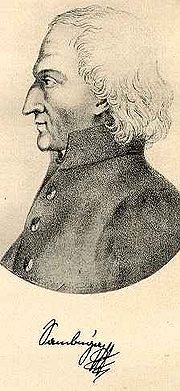
Joseph Anton Sambuga
Encyclopedia

Johann Michael Sailer
Johann Michael Sailer was a German Jesuit professor of theology and Bishop of Ratisbon.-Biography:Sailer was born at Aresing in Upper Bavaria on 17 October 1751 as the son of a poor shoemaker. Until his tenth year he attended the primary school in his native place; after this he was a pupil in the...
whose friend he was.
Biography
He was born at WalldorfWalldorf
Walldorf is a town in the Rhein-Neckar-Kreis of Baden-Württemberg in Germany.Walldorf is currently probably best known as the city that headquarters the world's third largest software company SAP, but it is also the birthplace of the millionaire John Jacob Astor, at the time of his death the...
near Heidelberg
Heidelberg
-Early history:Between 600,000 and 200,000 years ago, "Heidelberg Man" died at nearby Mauer. His jaw bone was discovered in 1907; with scientific dating, his remains were determined to be the earliest evidence of human life in Europe. In the 5th century BC, a Celtic fortress of refuge and place of...
on 9 June; 1752. His parents were Italians who had come from the neighbourhood of Como
Como
Como is a city and comune in Lombardy, Italy.It is the administrative capital of the Province of Como....
. He went to school at Mannheim
Mannheim
Mannheim is a city in southwestern Germany. With about 315,000 inhabitants, Mannheim is the second-largest city in the Bundesland of Baden-Württemberg, following the capital city of Stuttgart....
and to the monastic school of the Augustinians
Augustinians
The term Augustinians, named after Saint Augustine of Hippo , applies to two separate and unrelated types of Catholic religious orders:...
at Wiesloch
Wiesloch
Wiesloch is a city in Germany, in northern Baden-Württemberg. It is situated 13 kilometres south of Heidelberg.After Weinheim, Sinsheim and Leimen it is the fourth largest city of the Rhein-Neckar-Kreis and is in the north-central area near Heidelberg with its neighbouring town Walldorf...
and then entered the University of Heidelberg.
In 1770 family affairs took him to Italy where he finished his theological studies and was ordained priest at Como on 2 April 1774. After he had laboured at Como for a while as chaplain at the hospital he returned to Germany and in 1775 was made chaplain at Helmsheim, in 1778 chaplain and in 1783 court preacher at Mannheim, in 1785 parish priest at Herrnsheim.
In 1797 he was again called to the Court at Mannheim as teacher of religion to Prince Louis (later King Ludwig I of Bavaria
Ludwig I of Bavaria
Ludwig I was a German king of Bavaria from 1825 until the 1848 revolutions in the German states.-Crown prince:...
), the oldest son of Duke Maximilian Joseph. When Maximilian Joseph went to live at Munich
Munich
Munich The city's motto is "" . Before 2006, it was "Weltstadt mit Herz" . Its native name, , is derived from the Old High German Munichen, meaning "by the monks' place". The city's name derives from the monks of the Benedictine order who founded the city; hence the monk depicted on the city's coat...
as Elector of Bavaria (from 1806 King Maximilian I), Sambuga followed the Court to that city and was later the teacher of religion to the younger children of the Elector also. He died at Nymphenburg near the Bavarian capital Munich]] - on 5 June according to Sailer, but 5 January according to other statements- in 1815.

